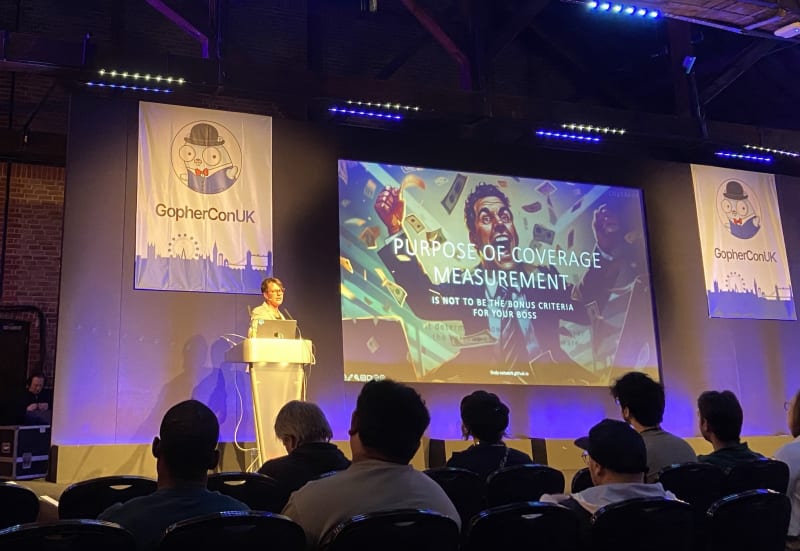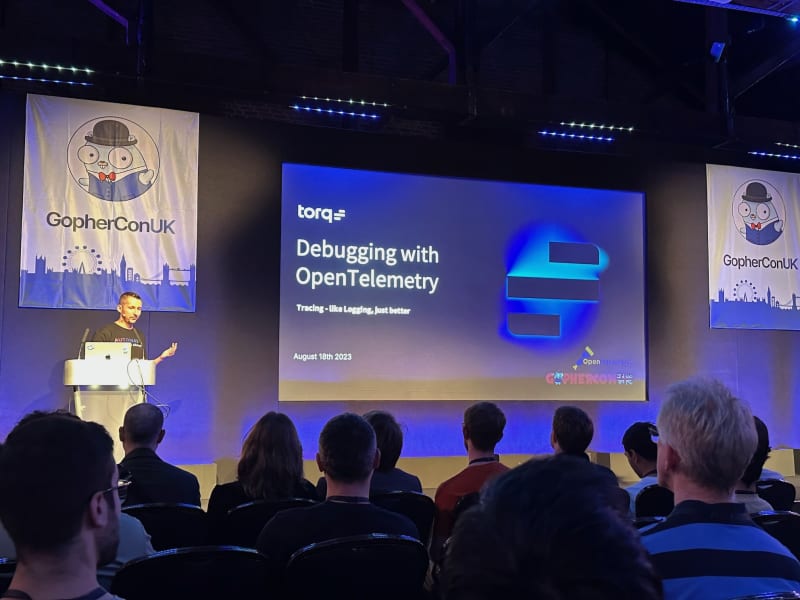At the beginning of this year, I set myself a target to speak at a Go programming language conference. There were several reasons to do so. Go has been one of my favorite tools for years, and I have longed for an excuse to join a Go event. Giving a speech was perfect for that purpose. Plus, I have
multiple excellent topics to share with the community as we do open-source development in our project, and I can share our learnings along with our code more freely. Furthermore, I want to do my part in having more diverse speakers at tech conferences.
As Go released 1.20, it inspired me to experiment with the new feature to gather coverage data for binaries built with Go tooling. I refactored our application testing pipelines and thought this would be an excellent topic to share with the community. I was lucky to get my speech accepted at GopherCon UK in London, so it was finally time to join my first Go conference.
 The Brewery hosted the event. Surprisingly for London, weather was excellent during the whole conference.
The Brewery hosted the event. Surprisingly for London, weather was excellent during the whole conference.
The conference was held in the Brewery, a relaxed event venue in London City. The word on the conference halls was that the number of event sponsors had decreased from the previous year, and therefore, it had been challenging to organize the event. Luckily, the organizers were able to pull things still together.
Apart from the recession, the times are now interesting for Gophers. Many good things are happening in the Go world. As Cameron Balahan pointed out in his talk "State of the Go Nation," Go is more popular than ever. More and more programmers have been adding Go to their tool pack in recent years, pushing language developers to add new and better features. Moreover, Go is not only a programming language anymore; it is a whole ecosystem with support for many kinds of tooling. Newcomers have a way easier job to start with development than, for example, I had seven years ago. Balahan stated that improving the onboarding of new developers is still one of the Go team's top priorities. He mentioned that they are working on the libraries, documentation, and error messages to help newcomers and all Go developers be more productive.
 Cameron Balahan is the product lead for Go.
Cameron Balahan is the product lead for Go.
Automated Testing and Test Coverage
The topic of my talk was "Boosting Test Coverage for Microservices." I described in the presentation how vital automated testing has become for our small team. Automated testing is usually the part you skip when time is running out, but I tried to convince the audience that this might not be the best approach – missing tests may bite you back in the end.
 On the stage. Photo by Tapan Avasthi
On the stage. Photo by Tapan Avasthi
Furthermore, I discussed test coverage in the presentation along with how one can measure test coverage for unit tests and now even - with the Go new tooling – for application tests, i.e., tests you run with the compiled application binary instead of unit testing tooling.
The audience received the talk well, and I got many interesting questions. People are struggling with similar issues when it comes to testing. It is tough to decide which functionality to simulate in the CI pipeline. Also, we discussed problems when moving on to automated testing with a legacy code base. The Go's new coverage feature was unknown to most people, and some were eager to try it out instantly after my session.
 All participants were given adorable Gopher mascots.
All participants were given adorable Gopher mascots.
Unfortunately, when you are a speaker at a conference, you cannot concentrate fully on the conference program because one needs to prepare for the talk. However, I was lucky enough to join some other sessions as well. There were mainly three themes that I gained valuable insights from.
Logging and tracing
Generating better logs and traces for applications seems to be a hot topic – and no wonder why. Services with high loads can generate countless amounts of data, and for the developers to use the logs for fixing issues efficiently, they must be able to filter and search them. The ability to debug each request separately is essential.
Jonathan Amsterdam from Google gave an inspiring presentation on the slog package, the newest addition to the standard library regarding logging. Go's default logging capabilities have always lacked features. The missing log levels have been the greatest pain point in my daily developer life. More importantly, the ability to send structured data to analysis tools is crucial for production systems. Until now, teams have had to use different kinds of 3rd party libraries for this to happen.
Now, the slog package fixes these shortcomings, with the ability to handle and merge the data from existing structured logging tools. The presentation revealed how the team refined the requirements for the new package together with the developer community. Also, it was fascinating to hear which kind of memory management tricks the team used, as the performance requirements for logging are demanding.
Another exciting presentation handled also the capability of solving problems quickly, but instead of logs, the emphasis was on tracing. Tracing provides a more detailed view of the program's data flow than logs and is especially useful when detecting performance bottlenecks. Konstantin Ostrovsky described how their team is using OpenTelemetry to add traceability to incoming requests. Using this approach, they do not need other logs in their codebase (excluding errors).
 Konstantin Ostrovsky presenting OpenTelemetry usage with Go.
Konstantin Ostrovsky presenting OpenTelemetry usage with Go.
OpenTelemetry tracing uses the concept of spans in the code. One can utilize the spans to store the request data parameters and call relationships. Different analysis tools can then visualize this data for a single request. According to Konstantin, these visualizations help developers solve problems faster than searching and filtering ordinary logs. However, in the presentation Q&A, he reminded us that one should use the spans sparingly for performance reasons.
Service Weaver
Service Weaver is an open-source project that another Google developer, Robert Grandl, presented at the conference. The tool allows one to develop a system as a monolith, as a single binary, but the underlying framework splits the components into microservices in deployment time. Therefore, development is easier when you do not have to worry about setting up the full microservices architecture on your local machine. In addition, the deployment might be more straightforward when you can work at a higher level.
I participated in a workshop that allowed participants to try the Service Weaver hands-on. The target was to build a full-blown web application with a web UI and a backend service from which the UI could request data. Other sections described testing the weaver components, routing from one service to another, and even calling external 3rd party services.
The workshop suited me well; I could learn more than just listening to a presentation. Furthermore, the topic interested me, and I will dig into it more in the coming days to better understand which kind of projects would benefit from this kind of development model the most. The workshop organizer promises that Google will not stop investing in the product. They are searching for collaborators to get more feedback to develop the product further.
UI development with Go
Another topic that got my interest was a discussion group for UI development with Go. Andrew Williams hosted this discussion and presented a project called Fyne that allows Gophers to write applications with graphical user interfaces for several platforms. UI development is not my favorite thing to spend my time on; therefore, I am always curious to find better, more fun ways to implement the mandatory user-clickable parts. Using Go would undoubtedly click the fun box. So, I added another technology experiment to my TODO list.
In addition to these three themes, one session that handled JWT security was also memorable. Patrycja Wegrzynowicz hacked the audience live with the help of a small sample application she had built for this purpose. It demonstrated which kind of vulnerabilities we Go developers might have in our JWT implementations.
 Patrycja hacking the audience with JWTs.
Patrycja hacking the audience with JWTs.
The presentation was informative and entertaining with the live hacking, and the audience understood the problems well due to the hands-on examples. The session proved that no well-known battle-tested documentation exists on handling the JWTs. We have (too) many different libraries with different qualities, and it is easy to make mistakes with the token generation and validation. No wonder the audience asked for a book on the subject from Patrycja – we need better resources for a topic as important as this.
See you in Florence
Overall, the event was well-organized, had a great atmosphere, and was fun to visit. Meeting fellow Gophers, especially the Women Who Go members, was a unique treat. Let's set up our chapter in Finland soon. (If you are a Finland-based woman who writes Go code, please reach out!) I also got to spend some free time in London and share the World Cup final atmosphere with the English supporters cheering for their team.
 Public viewing event for the World Cup final.
Public viewing event for the World Cup final.
Bye til the next event; I hope we meet in Florence in November! In the meantime, check out videos of the GopherCon UK 2023 sessions once they are published - I will do the same for the ones I missed live!







Top comments (0)